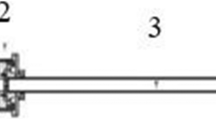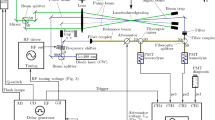Abstract
In expansion tube and shock tunnel facilities, freestream properties are generally inferred from the measurement of shock speeds using wall-mounted instrumentation. By measuring the shock arrival time at known locations along the facility wall, their spacing can be used to calculate the shock speed. These shock arrival measurements are generally taken using high-frequency pressure transducers. For operation at low pressures and shock speeds in excess of 10 km/s, the transducer rise time and its small voltage response to the passing shock wave can become the largest source of uncertainty in the found shock arrival time. In these situations, shock arrival can also be found optically by measuring the radiative emission of the passing shock wave using photomultiplier tubes or photodiodes, which can have rise times of much lower than a microsecond and potentially a larger voltage response to the passing shock wave. This paper presents a photodiode system that has been used to optically measure shock arrival in the X2 hypervelocity expansion tube at the University of Queensland. Experimental results show that for challenging low-density, high shock speed conditions, the photodiode system is able to measure shock arrival with a much larger signal-to-noise ratio than a comparable pressure transducer while operating with a similar or higher-frequency response. This behaviour makes the photodiode system an ideal sensor for detecting shock arrival in these situations.






Similar content being viewed by others
References
Sharma, S.P., Park, C.: Operating characteristics of a 60- and 10-cm electric arc-driven shock tube. Part II. The driven section. J. Thermophys. Heat Transf. 4(3), 266–272 (1990). https://doi.org/10.2514/3.56243
Morgan, R.: Free piston driven expansion tubes. In: Ben-Dor, G. (ed.) A Handbook of Shock Waves, vol. 1, chap. 4.3, pp. 603–622. Academic Press, Cambridge (2001)
Glass, I.I., Hall, J.G.: Handbook of Supersonic Aerodynamics. Section 18. Shock Tubes, Navord Report 1488. U.S. Government Printing Office, Washington, DC (1959)
Haslund, R., Charlson, R.: Localized shock velocity measurement techniques. In: Teel, G. (ed.) Proceedings of the Fourth Shock Tube Symposium, Ballistic Research Laboratories Report No. 1160, pp. 261–274. Aberdeen Proving Ground, MD, U.S.A., April 18–20, 1961 (1962)
Hey, J., Pinson, J., Smith, P.: A radio method of determining the velocity of a shock wave. Nature 179(4571), 1184–1185 (1957). https://doi.org/10.1038/1791184a0
Hey, J., Pinson, J., Smith, P.: Radio observations of hypersonic shock waves. Nature 182(4644), 1220–1221 (1958). https://doi.org/10.1038/1821220a0
Gerardo, J., Hendricks Jr., C., Goldstein, L.: Microwave studies of electrically driven shock waves. Phys. Fluids 6(9), 1222–1236 (1963). https://doi.org/10.1063/1.1706889
Hill, R.: Anomalous shock velocity measurements in argon using microwaves. Phys. Fluids 7(11), 1865–1866 (1964). https://doi.org/10.1063/1.2746788
Aro, T., Walsh, D.: Microwave interference method of measuring shock velocity in a shock tube. J. Sci. Instrum. 43(8), 572 (1966). https://doi.org/10.1088/0950-7671/43/8/328
Blum, R., Dunn, M.: Continuous measurement of shock velocity using a microwave technique. NASA CR-490, NASA, Washington (1966)
Dunn, M.: Application of microwave and optical diagnostic techniques in shock-tube and shock-tunnel flows. AIAA 3rd Aerodynamic Testing Conference, San Francisco, CA, AIAA Paper 1968–394 (1968). https://doi.org/10.2514/6.1968-394
Koch, B., König, M.: Digital measurements of the speed variations of shock waves by means of microwaves. Phys. Fluids 12(5), I–144 (1969). https://doi.org/10.1063/1.1692595
Laney Jr., C.C.: Microwave interferometry technique for obtaining gas interface velocity measurements in an expansion tube facility. NASA-TM-X-72625, NASA Langley Research Center, Hampton (1974)
Dufrene, A.T., Holden, M.S., Ringuette, M.J.: Microwave shock-speed diagnostic development and analysis of expansion tunnel viscous effects. AIAA J. 53(3), 573–587 (2015). https://doi.org/10.2514/1.J053139
Berets, D.J., Greene, E.F., Kistiakowsky, G.: Gaseous detonations. I. Stationary waves in hydrogen–oxygen mixtures. J. Am. Chem. Soc. 72(3), 1080–1086 (1950). https://doi.org/10.1021/ja01159a008
Li, Y.: High-frequency pressure indicators for aerodynamic problems. NACA Technical Note 3042, National Advisory Committee for Aeronautics, Washington (1953)
Knight, H.T.: Piezoelectric detector for low-pressure shock waves. Rev. Sci. Instrum. 29(2), 174–175 (1958). https://doi.org/10.1063/1.1716132
Duff, R.E.: Shock-tube performance at low initial pressure. Phys. Fluids 2(2), 207–216 (1959). https://doi.org/10.1063/1.1705910
Huppert, L., Kane, G., Bieber, M.: Design of a microminiature pressure transducer. TREC Technical Report 61-73, U.S. Army Transportation Research Command, Fort Eustis, VA, U.S.A. (1961)
PCB Piezotronics, I.: Model 112A22 High Resolution ICP Pressure Probe, 50 psi, 100 mV/psi, 0.218” dia. Installation and Operating Manual. PCB Piezotronics, Inc., Depew, N.Y., U.S.A. (2013)
Hooker, W.J.: Testing time and contact-zone phenomena in shock-tube flows. Phys. Fluids 4(12), 1451–1463 (1961). https://doi.org/10.1063/1.1706243
Fox, J., McLaren, T., Hobson, R.: Test time and particle paths in low-pressure shock tubes. Phys. Fluids 9(12), 2345–2350 (1966). https://doi.org/10.1063/1.1761624
Leibowitz, L.: Measurement of the structure of an ionizing shock wave in a hydrogen–helium mixture. Phys. Fluids 16, 59–68 (1973). https://doi.org/10.1063/1.1694174
Schultz, D.L., Jones, T.: Heat-transfer measurements in short-duration hypersonic facilities. Technical Report AGARDograp-165, AGARD (1973)
Roshko, A.: On flow duration in low-pressure shock tubes. Phys. Fluids 3(6), 835–842 (1960). https://doi.org/10.1063/1.1706147
James, C., Gildfind, D., Morgan, R., Lewis, S., McIntyre, T.: Experimentally simulating giant planet entry in an expansion tube. J. Spacecr. Rockets 57(4), 656–671 (2020). https://doi.org/10.2514/1.A34457
James, C.: Radiation from Simulated atmospheric entry into the gas giants. PhD Thesis, the University of Queensland, St Lucia, QLD, Australia (2018). https://doi.org/10.14264/uql.2018.697
Gildfind, D., Morgan, R.G., Jacobs, P.: Expansion tubes in Australia. In: Igra, O., Seiler, F. (eds.) Experimental Methods of Shock Wave Research, pp. 399–431. Springer, Switzerland (2016). https://doi.org/10.1007/978-3-319-23745-9_13
Morrison, R.B.: A shock tube investigation of detonative combustion. UMM-97, Willow Run Research Center, University of Michigan, Ann Arbor (1952)
Resler, E., Lin, S.C., Kantrowitz, A.: The production of high temperature gases in shock tubes. J. Appl. Phys. 23(12), 1390–1399 (1952). https://doi.org/10.1063/1.1702080
Knight, H.T., Duff, R.E.: Precision measurement of detonation and strong shock velocity in gases. Rev. Sci. Instrum. 26(3), 257–260 (1955). https://doi.org/10.1063/1.1771269
Lin, S.C., Fyfe, W.I.: Low-density shock tube for chemical kinetics studies. Phys. Fluids 4(2), 238–249 (1961). https://doi.org/10.1063/1.1724434
Dannenberg, R.E., Humphry, D.E.: Microsecond response system for measuring shock arrival by changes in stream electrical impedance in a shock tube. Rev. Sci. Instrum. 39(11), 1692–1696 (1968). https://doi.org/10.1063/1.1683204
Patrick, R.M.: High-speed shock waves in a magnetic annular shock tube. Phys. Fluids 2(6), 589–598 (1959). https://doi.org/10.1063/1.1705959
Camm, J.C., Rose, P.H.: Electric arc-driven shock tube. Phys. Fluids 6(5), 663–678 (1963). https://doi.org/10.1063/1.1706797
Levine, L.S.: Experimental investigations of normal ionizing shock waves. Phys. Fluids 11(7), 1479–1486 (1968). https://doi.org/10.1063/1.1692131
Cruden, B.: Absolute radiation measurements in Earth and Mars entry conditions. NATO RTO Lecture Series RTO-EN-AVT-218 (2014)
Resler Jr., E., Scheibe, M.: Instrument to study relaxation rates behind shock waves. J. Acoust. Soc. Am. 27(5), 932–938 (1955). https://doi.org/10.1121/1.1908082
Kiefer, J.H., Lutz, R.W.: Simple quantitative schlieren technique of high sensitivity for shock tube densitometry. Phys. Fluids 8(7), 1393–1394 (1965). https://doi.org/10.1063/1.1761417
Kiefer, J.H., Lutz, R.W.: Vibrational relaxation of deuterium by a quantitative schlieren method. J. Chem. Phys. 44(2), 658–667 (1966). https://doi.org/10.1063/1.1726741
Kiefer, J., Al-Alami, M., Hajduk, J.: Physical optics of the laser-schlieren shock tube technique. Appl. Opt. 20(2), 221–230 (1981). https://doi.org/10.1364/AO.20.000221
Fujita, K., Sato, S., Abe, T., Ebinuma, Y.: Experimental investigation of air radiation from behind a strong shock wave. J. Thermophys. Heat Transfer 16(1), 77–82 (2002). https://doi.org/10.2514/2.6654
Venable, D.: Positive ion oscilloscope trigger for shocks in low-density gases. Rev. Sci. Instrum. 26(7), 729 (1955). https://doi.org/10.1063/1.1715300
Venable, D., Kaplan, D.E.: Electron beam method of determining density profiles across shock waves in gases at low densities. J. Appl. Phys. 26(5), 639–640 (1955). https://doi.org/10.1063/1.1722058
Ballard, H., Venable, D.: Shock-front-thickness measurements by an electron beam technique. Phys. Fluids 1(3), 225–229 (1958). https://doi.org/10.1063/1.1724346
Knight, H.T., Venable, D.: Apparatus for precision flash radiography of shock and detonation waves in gases. Rev. Sci. Instrum. 29(2), 92–98 (1958). https://doi.org/10.1063/1.1716145
McChesney, M.: Shock tube beta-ray densitometer. J. Sci. Instrum. 38(12), 496 (1961). https://doi.org/10.1088/0950-7671/38/12/320
Gildfind, D.: X2 PCB Mount Assembly Drawing Set, Drawing Number x2-pcbmount1-000. https://espace.library.uq.edu.au/view/UQ:372806 (2015). Accessed 2 April 2021
Sheikh, U.: Re-entry radiation aerothermodynamics in the vacuum ultraviolet. PhD thesis, the University of Queensland, St Lucia, QLD, Australia (2014). https://doi.org/10.14264/uql.2014.305
Thorlabs, Inc.: Step-Index Multimode Fiber Optic Patch Cables: SMA to SMA. https://www.thorlabs.com/newgrouppage9.cfm?objectgroup_id=351 (2021). Accessed 2 April 2021
Tanno, H., Komuro, T., Lillard, R., Olejniczak, J.: Experimental study of high-enthalpy heat flux augmentation in shock tunnels. J. Thermophys. Heat Transfer 29, 858–862 (2015). https://doi.org/10.2514/1.T4478
James, C., Smith, D., McLean, C., Morgan, R., Lewis, S., Toniato, P., Wei, H., McIntyre, T.: Using optically filtered high speed imaging to characterise expansion tube operating conditions. Shock Waves 30(5), 523–544 (2020). https://doi.org/10.1007/s00193-020-00948-x
Thorlabs, I.: Thorlabs PDA36A(-EC) Si Switchable Gain Detector User Guide, Rev E, July 15, 2017. Thorlabs Inc, Newton (2017)
Thorlabs, I.: Thorlabs PDA20CS(-EC) InGaAs Switchable Gain Detector User Guide, Rev H, July 15, 2017. Thorlabs Inc, Newton (2017)
Thorlabs, Inc.: Photodiodes and photoconductors tutorials. https://www.thorlabs.com/newgrouppage9.cfm?objectgroup_id=9020 (2021). Accessed 2 April 2021
Robison, A., Applications Engineer, Thorlabs, Inc. (personal communication) (2021)
Thorlabs, Inc.: Terminated fiber adapters. https://www.thorlabs.com/newgrouppage9.cfm?objectgroup_id=69 (2021). Accessed 2 April 2021
Thorlabs, Inc.: BNC terminators. https://www.thorlabs.com/newgrouppage9.cfm?objectgroup_id=7312 (2021). Accessed 2 April 2021
Crystran Ltd: Calcium Fluoride (CaF2). https://www.crystran.co.uk/optical-materials/calcium-fluoride-caf2 (2021). Accessed 2 April 2021
James, C., Cullen, T., Wei, H., Lewis, S., Gu, S., Morgan, R., McInytre, T.: Improved test time evaluation in an expansion tube. Exp. Fluids 59(5) (2018). https://doi.org/10.1007/s00348-018-2540-1
Apirana, S., James, C., Lewis, S., Morgan, R., Zander, F.: Studying post-shock relaxation using a mach disk. 11th Asia-Pacific International Symposium on Aerospace Technology, Gold Coast, Australia, December 4–6 (2019)
Liu, Y., James, C., Morgan, R., McIntyre, T.: Using aerothermodynamic similarity to experimentally study nonequilibrium giant planet entry. J. Spacecr. Rockets 57(5), 1008–1020 (2020). https://doi.org/10.2514/1.A34713
Liu, Y., James, C.M., Morgan, R.G., McIntyre, T.J.: Experimental validation of a test gas substitution for simulating non-equilibrium giant planet entry conditions in impulse facilities. Exp. Fluids 61(9), 198 (2020). https://doi.org/10.1007/s00348-020-03032-3
James, C., Gildfind, D., Lewis, S., Morgan, R., Zander, F.: Implementation of a state-to-state analytical framework for the calculation of expansion tube flow properties. Shock Waves 28(2), 349–377 (2018). https://doi.org/10.1007/s00193-017-0763-3
Canny, J.: A computational approach to edge detection. IEEE Trans. Pattern Anal. Mach. Intell. 6, 679–698 (1986). https://doi.org/10.1109/TPAMI.1986.4767851
James, C.: Using a simplified canny edge detector to detect shock arrival in expansion tubes and shock tunnels. In: Proceedings of the 32nd International Symposium on Shock Waves, Paper 0031, pp. 651–672. Research Publishing, Singapore, July 15–19 (2019). https://doi.org/10.3850/978-981-11-2730-4_0031-cd
Zander, F., Morgan, R., Sheikh, U., Buttsworth, D., Teakle, P.: Hot-wall reentry testing in hypersonic impulse facilities. AIAA J. 51(2), 476–484 (2013). https://doi.org/10.2514/1.J051867
Mirels, H.: Test time in low-pressure shock tubes. Phys. Fluids 6, 1201–1214 (1963). https://doi.org/10.1063/1.1706887
Paull, A., Stalker, R.J.: Test flow disturbances in an expansion tube. J. Fluid Mech. 245(1), 493–521 (1992). https://doi.org/10.1017/S0022112092000569
James, C., Gildfind, D., Morgan, R., Lewis, S., McIntyre, T.: Simulating gas giant atmospheric entry using helium and neon test gas substitutions. J. Spacecr. Rockets 56(3), 725–743 (2019). https://doi.org/10.2514/1.A34282
Acknowledgements
The authors wish to thank: All X2 operators for their support with operating the facility, it would not be possible to keep X2 going without them; all of the X2 experimenters who tolerated any small delays when the authors were cleaning the window between experiments; R.G. Morgan who provided funding to purchase new equipment used for this project; the University of Queensland’s Summer Research Internship program which allowed undergraduate students to develop the physical system; K. Hitchcock, N. Duncan, B.V. Allsop, and the EAIT Faculty Workshop Group for technical support on X2; The Australian Research Council for support and funding; The Queensland Smart State Research Facilities Fund 2005 for support and funding.
Author information
Authors and Affiliations
Corresponding author
Additional information
Communicated by S. O’Byrne.
Publisher's Note
Springer Nature remains neutral with regard to jurisdictional claims in published maps and institutional affiliations.
Rights and permissions
About this article
Cite this article
James, C.M., Cox, D., Komonen, A. et al. Detecting shock arrival in expansion tubes and shock tunnels using high-frequency photodiodes. Shock Waves 31, 399–411 (2021). https://doi.org/10.1007/s00193-021-01026-6
Received:
Revised:
Accepted:
Published:
Issue Date:
DOI: https://doi.org/10.1007/s00193-021-01026-6




